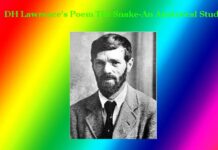The Theme of Love in Amoretti
The Theme of Love in Amoretti’
The Theme of Love in Amoretti
Edmund Spenser (1552- 1599) was one of the pioneers of English sonneteers. He wrote a sequence of 89 sonnets entitled ‘Amoretti’ in praise of his beloved Elizabeth Boyle. His notion of love as expressed in this sonnet sequence is traditional (classical or courtly) and Christian (spiritual). The traditional sense of love is almost one-sided lovemaking in which there are three phases as-in the first phase, the beloved remains indifferent and cruel to the poet (love-seeker) but the poet keeps persuading her to the love-making; in the second phase, the beloved seems to show sympathy and consents to the poet’s love-making and in the third phase, she turns again against the poet’s calling. The traditional sense of love is passionate about sexual attraction. On the other hand, the Christian sense of love is spiritual and almost ideological. It is free from amorous passion and the beloved is conceived of as the embodiment of spiritual salvation and the poet focuses on the virtues of his beloved rather than expressing amorous passion. Let us illustrate Spenser’s treatment of love in Amoretti with special reference to his representative sonnet nos. 34, 47 and 77.
Sonnet no.34 depicts the first phase of the classical or traditional sense of love. In it, the poet’s beloved seems to remain aloof from the poet. She is utterly indifferent to the poet’s calling. This sense of love is portrayed through the metaphor of a ‘sailor’ who is guided by the lodestar in the wide sea. The lodestar stands for the poet’s beloved by whose light the poet makes his way. But a ‘cloud’ or ‘storm’ (which signifies the cruelty of the poet’s beloved), has darkened the poet’s way for which the poet is wandering here and there without being able to reach his destination. But the poet is hopeful of getting the favour of his beloved. The poet says:
‘My Helice the lodestar of my life
Will shine again and look on me at last.’
Sonnet no. 47 is a representative sonnet of the second phase of the traditional sense of love-making. In this sonnet, we see that the poet’s cruel lover, at last, becomes kind to the poet and submits to the poet’s desire. The poet here again invokes a metaphor of a ‘huntsman’ and of a ‘deer’. The ‘huntsman’ refers to the poet himself and the ‘deer’ refers to his cruel beloved. The poet being a huntsman chases his pray ‘deer’. In the pursuit of his prey, the poet becomes much tired and sits under the shade of a tree for rest. Then the poet sees that the deer (beloved) has come to the poet willingly and consents to the poet’s passionate love-making. The poet says:
”The gentle deare returned the self-same way
Thinking to quench her thirst……”
Sonnet no. 77 is a representative sonnet where the poet spiritualizes his sense of love. It is free from carnal desire for his beloved; instead, he glorifies the physical beauty or virtues of his beloved. The poet says that his beloved is rich in beauty and virtues. Her two breasts are apples of valuable price. But there is no carnal attraction for the poet. He says:
”Two golden apples of valuable price
…………………..
Exceedingly sweet, yet void of sinful vice.”
Thus from the illustration of Spenser’s three representative sonnets from ‘Amoretti’, it is seen that love is the sole theme of his sonnets the treatment of which is both traditional and Christian or conventional and spiritual. 0 0 0
Read More: The Art of Characterisation in Chaucer’s Canterbury Tales
N. B. This article entitled ‘The Theme of Love in Amoretti’ originally belongs to the book ‘Critical Essays on English Poetry‘ by Menonim Menonimus. The Theme of Love in Amoretti
Books of Literary Criticism by M. Menonimus:
- World Short Story Criticism
- World Poetry Criticism
- World Drama Criticism
- World Novel Criticism
- World Essay Criticism
- Indian English Poetry Criticism
- Indian English Poets and Poetry Chief Features
- Emily Dickinson’s Poetry-A Thematic Study
- Walt Whitman’s Poetry-A Thematic Study
- Critical Essays on English Poetry
- Tawfiq al-Hakim’s Novel: Return of the Spirit-An Analytical Study
- Tawfiq al-Hakim’s Novel: ‘Yawmiyyat Naib Fil Arayaf’-An Analytical Study
- Analytical Studies of Some Arabic Short Stories
- A Brief History of Arabic Literature: Pre-Islamic Period …











